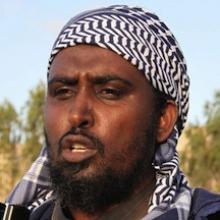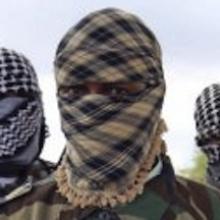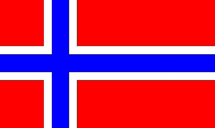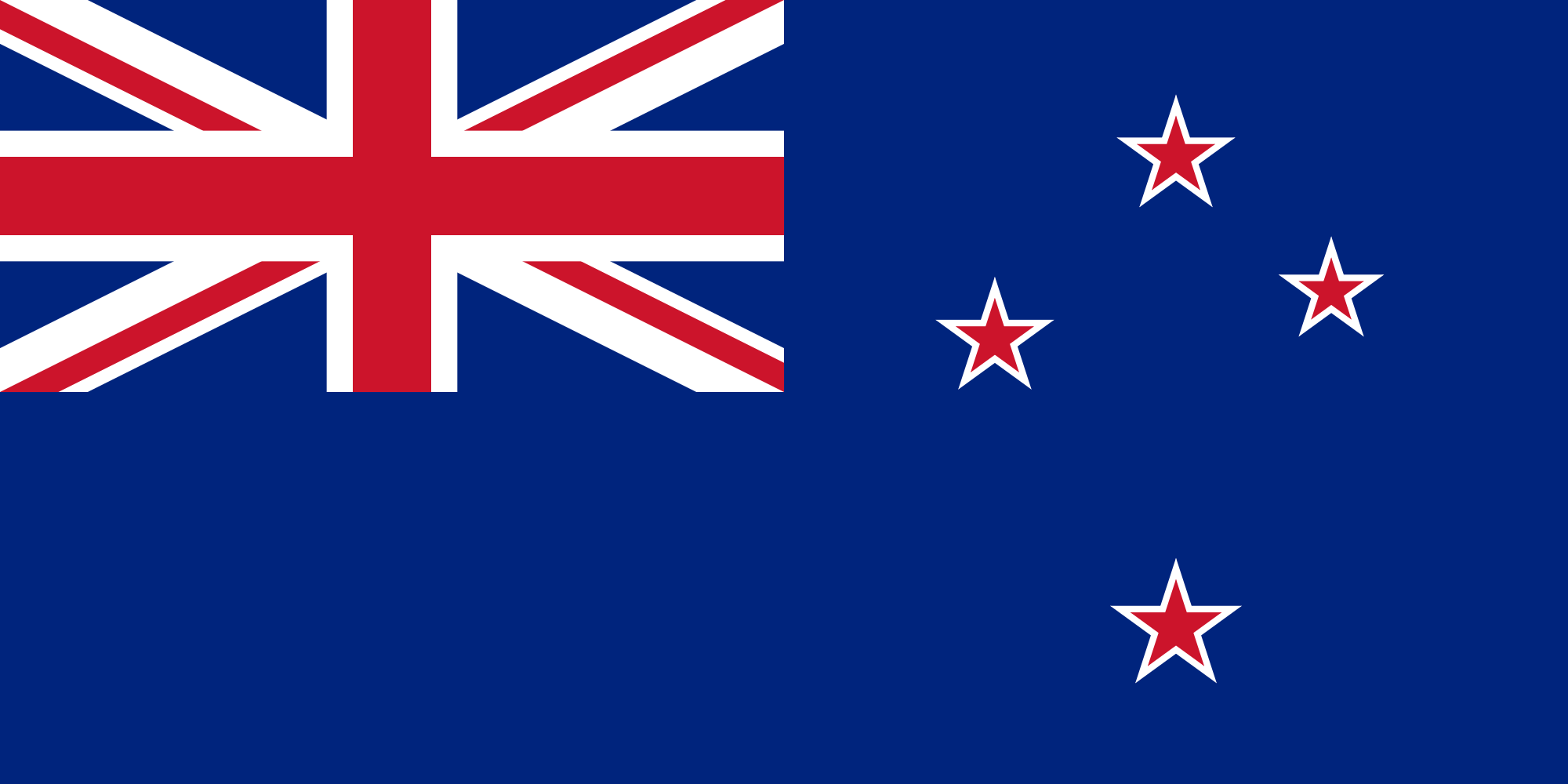Ahmed Diriye (a.k.a. Abu Diriye, Ahmed Umar Abu Ubaidah)
Al-Shabaab emir (leader)
Al-Qaeda’s Somali-based branch, al-Shabaab, seeks to establish a fundamentalist Islamic state. The group has carried out a score of violent terror attacks, including the September 2013 Westgate Mall attacks in Nairobi, Kenya.
August 2, 2024: An al-Shabaab suicide bomber detonates an explosive in front of the Beach View Hotel close to Lido Beach in Mogadishu. After the explosion, gunmen storm the surrounding area. The explosion and gunfire kill at least 37 and injure 247 others. The dual method assault is the most lethal carried out by al-Shabaab since October 2022, when twin bombings at a Mogadishu market killed 100 and wounded 300 others.“Somalia beach attack kills 37 civilians, minister says,” Reuters, August 3, 2024, https://www.reuters.com/world/africa/explosion-goes-off-beach-somali-capital-prime-minister-says-2024-08-02/; “Somalia: Al-Shabaab militants carry out attack on hotel in Mogadishu's Lido Beach area, killing at least 20 people late Aug. 2. Tight security likely /update 1,” Crisis 24, August 2, 2024, https://crisis24.garda.com/alerts/2024/08/somalia-al-shabaab-militants-carry-out-attack-on-hotel-in-mogadishus-lido-beach-area-killing-at-least-20-people-late-aug-2-tight-security-likely-update-1; “Death Toll Hits 37 After Al-Shabaab Attacks Mogadishu Beach,” Defense Post, August 5, 2024, https://www.thedefensepost.com/2024/08/05/somalia-mogadishu-beach-attack/; “Saudi Arabia condemns Mogadishu beach attack, stands with Somalia,” Garowe Online, August 4, 2024, https://www.garoweonline.com/en/news/somalia/saudi-arabia-condemns-mogadishu-beach-attack-stands-with-somalia.
Al-Shabaab, or “the Youth,” is al-Qaeda’s formal affiliate in East Africa. Established in the late 1990s, the Somali-based terror group seeks to establish a fundamentalist Islamic state in the country that it hopes will ultimately expand to encompass the whole Horn of Africa. Al-Shabaab controls much of the southern Somalia region and small pockets in Kenya and Ethiopia along the Somali border. In areas under the group’s control, al-Shabaab imposes its strict version of sharia (Islamic law), prohibiting activities like listening to music or shaving one’s beard. The group predominately conducts attacks targeting the Somali government and the African Union Mission to Somalia (AMISOM). On March 31, 2022, the U.N. Security Council voted unanimously to endorse the African Union’s new transitional mission in Somalia. The new mission, African Union Transition Mission in Somalia (ATMIS), will replace AMISOM, which has been in operation in the country for 15 years.Edith M. Lederer, “UN authorizes new AU mission in Somalia to combat extremists,” Associated Press, March 31, 2022, https://apnews.com/article/islamic-state-group-united-nations-somalia-africa-al-qaida-1de66eb262ec3d4287f2e6a7102856f1?utm_source=iterable&utm_.
According to a letter al-Qaeda leader Osama bin Laden addressed to unidentified al-Shabaab officials, al-Shabaab has reportedly been loyal to al-Qaeda since before August 2010. However, bin Laden urged the group to not publicly identify itself as part of al-Qaeda.Peter Bergen, “The Last Days of Osama bin Laden,” Wall Street Journal, July 30, 2021, https://www.wsj.com/articles/the-last-days-of-osama-bin-laden-11627657283. Following the group’s pledge of allegiance to al-Qaeda in 2012, al-Shabaab began executing a score of violent attacks in Somalia’s neighboring countries, including the September 2013 Westgate Mall attacks in Nairobi, Kenya, which left 68 people dead and 175 wounded. The group is also responsible for the April 2015 Garissa University attacks, wherein five al-Shabaab fighters stormed the Kenyan university, killing nearly 150 people. Since then, the group has continued to attempt and conduct terrorist attacks outside of its stronghold in Somalia. In al-Shabaab’s first attempt to attack Western targets, an assailant detonated a concealed laptop bomb on a Daallo Airlines flight leaving Mogadishu for Djibouti City on February 2, 2016. The explosion, which killed only the attacker, was not strong enough to down the plane. Al-Shabaab reportedly killed more than 4,200 people in 2016, making it the deadliest Islamic terror group in Africa. In October 2017, al-Shabaab was credited with the worst terror attack in Somalia to date––a truck bomb that killed over 300 people in Mogadishu.Jason Burke, “Mogadishu truck bomb: 500 casualties in Somalia’s worst terrorist attack,” Guardian (London), October 16, 2017, https://www.theguardian.com/world/2017/oct/15/truck-bomb-mogadishu-kills-people-somalia; Jason Burke, “Mogadishu bombing: al-Shabaab behind deadly blast, officials say,” Guardian (London), October 16, 2017, https://www.theguardian.com/world/2017/oct/16/mogadishu-bombing-al-shabaab-behind-deadly-blast-officials-say.
Al-Shabaab’s ideology is typically described as a brand of Salafism and Wahhabism that supports takfir, the excommunication of apostates or unbelievers. Though it has stated many goals in the past, the group fights first and foremost to create a fundamentalist Islamic state in the Horn of AfricaJonathan Masters and Mohammed Aly Sergie, “Al-Shabab,” Council on Foreign Relations, last modified March 13, 2015, http://www.cfr.org/somalia/al-shabab/p18650. that would include not only Somalia but also Djibouti, Kenya, and Ethiopia.Abdisaid M. Ali, “The Al-Shabaab Al Mujahidiin: A Profile of the First Somali Terrorist Organization,” Das Institut für Strategie- Politik- Sicherheits- und Wirtschaftsberatung, June 2, 2008, http://kms2.isn.ethz.ch/serviceengine/Files/ESDP/55851/ipublicationdocument_singledocument/1dd66bc5-b0c9-488c-b7e9-d16eeac91018/en/AlShabaab.pdf.
Under al-Shabaab’s strict brand of sharia, stonings, amputations, and beheadings are regular punishment for criminals and apostates. The group violently persecutes non-Muslims and clashes frequently with humanitarian and international aid workers.Jonathan Masters and Mohammed Aly Sergie, “Al-Shabab,” Council on Foreign Relations, March 13, 2015, http://www.cfr.org/somalia/al-shabab/p18650. Out of an estimated 6,000-12,000 fighters as of March 2016, only a small handful are believed to be ethnically non-Somali.Alexander Meleagrou-Hitchens and Abdihakim Ainte, “The Return of al-Shabaab,” Daily Beast, March 15, 2016, http://www.thedailybeast.com/articles/2016/03/15/the-return-of-al-shabaab.html.
The precursor to al-Shabaab is Somali rebel group al-Itihad al-Islami (AIAI), which targeted the Siad Barre military regime during the Somali Civil War in the 1990s. After the Barre regime fell, a younger, more hardline group split from the AIAI, seeking to extend AIAI’s mission and establish a “Greater Somalia” ruled under sharia. This group of youths—in Arabic, “al-Shabaab”—joined forces with the Islamic Courts Union (ICU) in an attempt to enforce sharia throughout Mogadishu. In December 2006, U.S.-backed Ethiopian forces invaded Somalia and drove the ICU out of the capital. Though the majority of the ICU fled to neighboring countries, al-Shabaab retreated southward and began organizing attacks against the Ethiopian forces. In this way, al-Shabaab transitioned from a rebel group into a guerrilla movement and began seizing territory in central and southern Somalia.Jonathan Masters and Mohammed Aly Sergie, “Al-Shabab,” Council on Foreign Relations, March 13, 2015, http://www.cfr.org/somalia/al-shabab/p18650. Al-Shabaab grew from a few hundred fighters in the 2006 to thousands by 2008, as Islamist-nationalist fighters sought to drive out the Ethiopian occupation.Jonathan Masters and Mohammed Aly Sergie, “Al-Shabab,” Council on Foreign Relations, March 13, 2015, http://www.cfr.org/somalia/al-shabab/p18650. Since the end of the Ethiopian occupation in 2008, al-Shabaab has continued to its efforts to establish sharia domestically and attack government representatives and African Mission forces, while also adapting its foreign targets from Ethiopia to Kenya following a brief Kenyan invasion in 2011. Al-Shabaab views the AMISOM—and as of 2022, AMISOM’s replacement, the African Union Transition Mission in Somalia (ATMIS)—as well as the Somalia Federal Government, as its primary enemies since they are purportedly influenced by Western countries.Jonathan Masters and Mohammed Aly Sergie, “Al-Shabab,” Council on Foreign Relations, March 13, 2015, http://www.cfr.org/somalia/al-shabab/p18650.
Al-Shabaab formally pledged allegiance to al-Qaeda in 2012, though ties between them existed since 2008, when the American-born al-Qaeda in the Arabian Peninsula (AQAP) cleric Anwar al-Awlaki released a statement praising al-Shabaab for fighting against the U.S.-backed Ethiopian invasion. In 2010, AQAP deputy leader Said al-Shihri also released a statement encouraging al-Shabaab to work with his group in its fight against the United States.Ty McCormick, U.S. Attacks Reveal Al-Shabab’s Strength, Not Weakness,” Foreign Policy, March 9, 2016, http://foreignpolicy.com/2016/03/09/u-s-attacks-reveal-al-shababs-strength-not-weakness-somalia/. Following the pledge of allegiance, some al-Qaeda fighters who trained at camps in Afghanistan moved to Somalia to train members of al-Shabaab. The two groups continue to cooperate closely, on everything from indoctrination and basic infantry skills to advanced explosives and assassination training. Al-Shabaab and AQAP partake in the transfer of fighters and weapons between Yemen and Somalia. Al-Shabaab fighters have been able to obtain new weapons and develop new tactics from AQAP, including the use of laptop explosives and more destructive car bombs.Ty McCormick, U.S. Attacks Reveal Al-Shabab’s Strength, Not Weakness,” Foreign Policy, March 9, 2016, http://foreignpolicy.com/2016/03/09/u-s-attacks-reveal-al-shababs-strength-not-weakness-somalia/. Al-Qaeda reportedly plays an important role in al-Shabaab’s leadership, with one count reporting that foreigners comprise over half of al-Shabaab’s executive council and that the group has embraced globalized rhetoric and propaganda.
Analysts cite the early militant Salafi extremist group al-Itihad al-Islami (AIAI, a.k.a. Unity of Islam) as the precursor to al-Shabaab and the incubator for many of its leaders. AIAI peaked in the 1990s after the Siad Barre military regime fell and civil war broke out.Jonathan Masters, “Al-Shabab,” Council on Foreign Relations, last modified September 5, 2014, http://www.cfr.org/somalia/al-shabab/p18650. A younger, hardline group split from the elder AIAI, seeking to establish a “Greater Somalia” ruled under sharia. This group of youths joined forces with the Islamic Courts Union (ICU), a group of sharia courts, to serve as a governance alternative once they overtook Mogadishu. The combined group was eventually pushed out by Ethiopia. Much of the ICU fled to the south of Somalia and al-Shabaab emerged and continued asymmetrical attacks on Ethiopian targets.
This context is important in understanding a key characteristic of the group—it is not monolithic and is prone to internal fissures over strategy and tactics. These conflicts became particularly significant when whole clans broke from al-Shabaab in 2008. Reports highlighted increased leadership conflicts over tactics, clan interests, affiliations with al-Qaeda, and policies toward international aid agencies.Ken Menkhaus, “Al-Shabab’s Capabilities Post-Westgate,” CTC Sentinel 7, no. 2 (February 2014): 4-9, https://www.ctc.usma.edu/v2/wp-content/uploads/2014/02/CTCSentinel-Vol7Iss2.pdf.
Ahmed Abdi Godane eventually triumphed over internal opposition with a series of purges in 2011 and a particularly bloody internal battle in June 2013. One of the implications of Godane’s victory is that the core group’s doctrine and affiliation seem to have been settled. Though al-Shabaab has always had a Salafist jihadist orientation, the group’s leadership was once heterogeneous, including nationalist and politically pragmatic figures like Hassan Dahir Aweys and Mukhtar Robow. The al-Shabaab that triumphed arose from the extreme fringe, steeped in the takfiri ethos that legitimizes the killing of other Muslims and a recommitment to global jihad and restoration of the Caliphate. Matt Bryden, “The Reinvention of Al-Shabaab: A Strategy of Choice or Necessity,” Center for Strategic & International Studies, February 2014, http://csis.org/files/publication/140221_Bryden_ReinventionOfAlShabaab_Web.pdf.
Godane, no longer faced with internal opposition to aligning with al-Qaeda, officially pledged al-Shabaab’s allegiance to that group in 2012. Afterward, some al-Qaeda fighters who trained at camps in Afghanistan moved to Somalia to train members of al-Shabaab. The two groups continue to cooperate closely on everything from indoctrination and basic infantry skills to advanced explosives and assassination training. Al-Qaeda reportedly plays an important role in al-Shabaab’s leadership, with one count reporting that foreigners comprise over half of al-Shabaab’s executive council and that the group has embraced globalized rhetoric and propaganda. Fred Dews, “Al Shabaab: Background on the Somalia-based Terrorist Group that Attacked a Nairobi Mall,” Brookings Institutition, September 23, 2013, http://www.brookings.edu/blogs/brookings-now/posts/2013/09/al-shabaab-somalia-terrorist-nairobi-mall-attack. Out of an estimated 3,000 to 5,000 fighters, 200 to 300 are non-Somali, with a number coming from the Somali diaspora.Fred Dews, “Al Shabaab: Background on the Somalia-based Terrorist Group that Attacked a Nairobi Mall,” Brookings Institutition, September 23, 2013, http://www.brookings.edu/blogs/brookings-now/posts/2013/09/al-shabaab-somalia-terrorist-nairobi-mall-attack.
Following Godane’s death in 2014, Ahmed Umar Abu Ubaidah, previously known as Ahmed Diriye, was appointed as emir. In November 2019, Ubaidah appeared in a video for the first time and named the United States as the group’s primary target and demanded supporters attack Americans wherever they could.Harun Maruf, “Al-Shabab Chief Partially Seen on Video for First Time,” Voice of America, November 5, 2019, https://www.voanews.com/africa/al-shabab-chief-partially-seen-video-first-time.
Al-Shabaab is a hierarchical organization led by its emir (“prince” or “commander”) Ahmed Umar Abu Ubaidah. Answering to Abu Ubaidah are a set of regional commanders who manage the group’s presence in southern Somalia and Mogadishu, Bay and Bokool, Puntland and Somaliland, and Juba Valley.Abdi O. Shuriye, “Research: Al-shabaab’s Leadership Hierarchy and its Ideology,” Horn Affairs, May 7, 2012, http://hornaffairs.com/en/2012/05/07/research-al-shabaabs-leadership-hierarchy-and-its-ideology/.
Abu Ubaidah has also appointed a Shura council of 10 members who oversee al-Shabaab’s regional commanders. The council establishes al-Shabaab’s policy, which is expected to be followed by local administrations within the group’s territory.Abdi O. Shuriye, “Research: Al-shabaab’s Leadership Hierarchy and its Ideology,” Horn Affairs, May 7, 2012, http://hornaffairs.com/en/2012/05/07/research-al-shabaabs-leadership-hierarchy-and-its-ideology/;
“Al Shabaab Leadership Profiles,” AEI Critical Threats, accessed September 13, 2016, http://www.criticalthreats.org/somalia/al-shabaab-leadership. Aiding the Shura council are junior leaders who are in charge of al-Shabaab’s media branch, law enforcement, and military operations. The group’s media branch, al-Kataib (The Brigade), is responsible for producing video recruitment and propaganda content which is then disseminated for international audiences.“Mapping Militant Organizations: Al Shabaab,” Stanford University, accessed September 12, 2016, http://web.stanford.edu/group/mappingmilitants/cgi-bin/groups/view/61;
Abdi O. Shuriye, “Research: Al-shabaab’s Leadership Hierarchy and its Ideology,” Horn Affairs, May 7, 2012, http://hornaffairs.com/en/2012/05/07/research-al-shabaabs-leadership-hierarchy-and-its-ideology/.
The leader of al-Shabaab’s military operations, previously Abdullahi Haji Da’ud, Bill Roggio, “US military targets senior Shabaab commander in Somalia,” Long War Journal, June 1, 2016, http://www.longwarjournal.org/archives/2016/06/us-military-targets-senior-shabaab-commander-in-somalia.php. oversees two separate branches, the Jaysh Al-‘Usr (army of hardship) and the Jaysh Al-Hisbah (army of morality). Led by regional military leaders, the Jaysh Al-‘Usr serves as the group’s major external military apparatus. The Jaysh Al-Hisbah functions as the group’s religious police force, enforcing sharia in areas of al-Shabaab’s control.Abdi O. Shuriye, “Research: Al-shabaab’s Leadership Hierarchy and its Ideology,” Horn Affairs, May 7, 2012, http://hornaffairs.com/en/2012/05/07/research-al-shabaabs-leadership-hierarchy-and-its-ideology/.
Al-Shabaab has had several sources of income throughout its history, including varying degrees of support from the Somali diaspora, locals, sponsors, and sustained dawa (proselytizing).
Domestically, al-Shabaab drew significant revenue from racketeering after seizing the southern port city of Kismayo in 2008. The charcoal trade was essential to the city’s economy and the group was able to receive proceeds from exporting charcoal, totaling an estimated $35-50 million annually.Jonathan Masters and Mohammed Aly Sergie, “Al-Shabab,” Council on Foreign Relations, last modified March 13, 2015, http://www.cfr.org/somalia/al-shabab/p18650. Although AMISOM was able to take back Kismayo in October 2012, the United Nations has reported that al-Shabaab’s illicit charcoal trade has continued in areas under the group’s control, such as Barawe, and estimates that profits from this city alone amount to millions of dollars monthly.“Letter dates 12 July 2013 from the Chair of the Security Council Committee pursuant to resolutions 751 (1992) ad 1907 (2009) concerning Somalis and Eritrea addressed to the President of the Security Council,” United Nations Security Council, July 12, 2014, http://www.un.org/ga/search/view_doc.asp?symbol=S/2013/413. The United Nations banned charcoal exports from Somalia in 2012. In October 2014, as part of an effort to target al-Shabaab’s funding, the U.N. Security Council authorized the inspection of ships suspected of carrying Somali charcoal.Edith M. Lederer, “UN authorizes ship inspections for Somali charcoal,” Associated Press, October 24, 2014, http://bigstory.ap.org/article/e8fe2a9961754c3b80c00f68c550dc6e/un-authorizes-ship-inspections-somali-charcoal.
According to the U.N., sugar imports grew in late 2012, in connection with the increased production of charcoal, and thereafter increased for transport over the Kenyan border. “Letter dates 12 July 2013 from the Chair of the Security Council Committee pursuant to resolutions 751 (1992) ad 1907 (2009) concerning Somalis and Eritrea addressed to the President of the Security Council,” United Nations, July 12, 2014, http://www.un.org/ga/search/view_doc.asp?symbol=S/2013/413. This cyclical trade, with charcoal exports in return for sugar imports that are eventually sold in Kenya for a lower price, is one way the group has sustained itself, despite losing control of the Kismayo port. Al-Shabaab is also able to facilitate cash flows within Somalia through the rise of mobile money transfer companies subject to less scrutiny.“Somalia: Al-Shabaab—It will be a Long War,” International Crisis Group, June 26, 2014, http://www.crisisgroup.org/~/media/Files/africa/horn-of-africa/somalia/b099-somalia-al-shabaab-it-will-be-a-long-war.pdf. The International Crisis Group also reported in 2014 that al-Shabaab copes with a volatile financial environment and intermittent cash flow by investing in gold. “Somalia: Al-Shabaab—It will be a Long War,” International Crisis Group, June 26, 2014, http://www.crisisgroup.org/~/media/Files/africa/horn-of-africa/somalia/b099-somalia-al-shabaab-it-will-be-a-long-war.pdf.
After the June 2013 purge of Godane’s opposition within the leadership, al-Shabaab shifted its attention toward “taxation”—specifically, collecting funds through voluntary support, extortion, and partnership with businesses, humanitarian agencies, and other non-governmental organizations that operate in south-central Somalia.Ken Menkhaus, “Al-Shabab’s Capabilities Post-Westgate,” CTC Sentinel 7, no. 2 (February 2014): 4-9, https://www.ctc.usma.edu/v2/wp-content/uploads/2014/02/CTCSentinel-Vol7Iss2.pdf.According to the United Nations, al-Shabaab has generated up to $100 million per year, from fees levied at ports of entry, taxes on goods, taxes on domestic produce, “jihad contributions,” checkpoint fees, and extortion for payments of religious obligation. “Report of the Monitoring Group on Somalia and Eritrea pursuant to Security Council resolution 1916,” United Nations Security Council, July 18, 2011, http://www.un.org/ga/search/view_doc.asp?symbol=S/2011/433.
Central to al-Shabaab’s taxation and extortion practices is the use of roadblocks between Baidoa and Mogadishu as well as between Mogadishu and the Lower Shabelle region. Each roadblock along these paths earns al-Shabaab $5,000 a day extorting merchants. This money largely comes from money distributed to internally displaced persons (IDPs) by the United Nations and associated aid agencies. The United Nations issues IDPs living in refugee camps in Baidoa cash cards of $80 to $90 a month, which allows them to purchase necessities from merchants traveling from Mogadishu. On their way to and from Baidoa, these merchants are stopped and taxed at al-Shabaab roadblocks, thereby unwillingly transferring U.N. funds to the terror group. While the regional Somali government and the United Nations have confirmed these practices, the U.N.’s head of country, Michael Keating, has insisted that most of the aid still reaches IDPs.Sam Kiley, “Funding al-Shabaab: How aid money ends up in terror group's hands,” CNN, February 12, 2018, https://www.cnn.com/2018/02/12/africa/somalia-al-shabaab-foreign-aid-intl/index.html.
Al-Shabaab has also reportedly received funding from the governments of Eritrea, Iran, Saudi Arabia, Syria, Qatar, and Yemen, the majority of which have denied these claims.Holly Yan, “What is Al-Shabaab, and what does it want?” CNN, April 2, 2015, http://www.cnn.com/2015/04/02/world/africa/al-shabaab-explainer/;
Jonathan Masters and Mohammed Aly Sergie, “Al-Shabab,” Council on Foreign Relations, March 13, 2015, http://www.cfr.org/somalia/al-shabab/p18650. Al-Shabaab agents have also raised funds internationally. For example, in September 2014, prosecutors in Finland charged four people who allegedly collected “thousands of euros” for al-Shabaab between 2008 and 2011.“Finland: 4 charged with funding Somali militants,” Associated Press, September 17, 2014, http://bigstory.ap.org/article/finland-4-charged-funding-somali-militants. In October 2016, two women in the United States were convicted for organizing a group of women from eight different countries that funded al-Shabaab.“Two women convicted in US of Financing Somali Group Al-Shabab,” Voice of America, October 25, 2016, https://www.voanews.com/a/two-women-us-convicted-financing-somali-group-al-shabaab/3566479.html.
Al-Shabaab’s recruitment efforts take place primarily within Somalia and Kenya, though its online recruitment strategy has targeted the United States as well. “Al-Shabaab Recruitment from Kenyan Universities Alarms Officials,” Jamestown Foundation, January 7, 2016, http://www.jamestown.org/programs/tm/single/?tx_ttnews%5Btt_news%5D=44951&cHash=abb508bc030cbed438bb4b009236f6b5#.V9b_64WcGM8;
African terror group Al Shabaab finds American recruits to aid jihad missions, Fox News, February 4, 2016, http://www.foxnews.com/world/2016/02/04/african-terror-group-al-shabaab-finds-american-recruits-to-aid-jihad-missions.html;
Matt Smith, “Somali jihadists recruit in U.S., Canada, Europe, CNN, September 23, 2013, http://www.cnn.com/2013/09/22/us/kenya-attack-somalis/.
Staying true to its name, which means “The Youth,” al-Shabaab seeks to recruit Somali adolescents and young adults. Anneli Botha and Mahdi Abdile, “Radicalisation and al-Shabaab recruitment in Somalia,” Institute for Security Studies, September 2014, 2, 6, http://www.issafrica.org/uploads/Paper266.pdf. Boys as young as 9 years old have been forced into al-Shabaab’s ranks. Mohamed Olad Hassan, “Somali Children Flee Al-Shabab Recruitment,” Voice of America, August 7, 2017, https://www.voanews.com/a/somali-children-seek-refuge-al-shabab-coastal-town-adale/3975825.html. In January 2017, U.N. Secretary-General Antonio Guterres estimated that more than half of al-Shabaab’s fighters may be children. A Somali taskforce recorded the recruitment of 4,213 children—almost all boys—into al-Shabaab between April 1, 2010, and July 31, 2016. According to a 2017 U.N. report, children “recruited and used by al-Shabaab were victims of or were exposed to other grave violations including killing and maiming during military operations and air strikes targeting al-Shabaab, and subjected to arrest and detention by Somalia security forces.”Edith M. Lederer, “UN alarm that most of al-Shabab’s force in Somalia are kids,” Associated Press, January 20, 2017, https://apnews.com/85093315baa644a6bee802b13fc343e5/un-alarm-most-al-shababs-force-somalia-are-kids.
According to Somali officials, al-Shabaab needs younger recruits to replace aging fighters. The group has kidnapped children from schools, forcing others to flee al-Shabaab-controlled areas to avoid conscription. In early August 2017 alone, more than 100 children fled from al-Shabaab-controlled areas of Somalia for the safety of government-controlled areas of the country. Officials have estimated that more than 500 children have fled their homes to escape conscription into al-Shabaab.Mohamed Olad Hassan, “Somali Children Flee Al-Shabab Recruitment,” Voice of America, August 7, 2017, https://www.voanews.com/a/somali-children-seek-refuge-al-shabab-coastal-town-adale/3975825.html.
Al-Shabaab uses children in combat and reconnaissance roles, according to the U.N. “Somalia,” United Nations Office of the Special Representative of the Secretary General for Children and Armed Conflict, May 15, 2014, https://childrenandarmedconflict.un.org/countries/somalia/. A 14-year-old Somali recruit, interviewed by the Institute for Security Studies in September 2014, said, “[W]hen you join, they give you a mobile phone and every month you get $50. This is what pushes a lot of my friends to join.” Another member recalled how during his recruitment experience “[P]reachers delivered sermons for hours about destiny and the sweetness of the holy war. They distributed leaflets on Islam [and] showed video recording from other jihadist [sic] in the world.” Anneli Botha and Mahdi Abdile, “Radicalisation and al-Shabaab recruitment in Somalia,” Institute for Security Studies, September 2014, 2, 6, http://www.issafrica.org/uploads/Paper266.pdf.
While al-Shabaab recruits males, it has also kidnapped Muslim and Christian women in Somalia and Kenya as sex slaves. The group has forced some girls and women to work in brothels while forcing others into marriages with al-Shabaab fighters. Charlotte Attwood, “The sex slaves of al-Shabab,” BBC News, May 25, 2017, http://www.bbc.com/news/magazine-40022953. Al-Shabaab has regularly killed women and girls who refuse forced marriages to al-Shabaab fighters. “No Place for Children,” Human Rights Watch, February 20, 2012, https://www.hrw.org/report/2012/02/20/no-place-children/child-recruitment-forced-marriage-and-attacks-schools-somalia.
Al-Shabaab has attempted to influence Somali families toward Islamism. The group’s Education and Youth Engagement released its own curriculum in early 2017, focusing only on Quran, math, history, and geography. Ludovica Iaccino, “Al-Shabab Urges Parents to Send Their Children to Islamic Schools to Avoid Western Influences,” Newsweek, April 21, 2017, http://www.newsweek.com/al-shabab-somalia-islamic-schools-militants-al-qaeda-587260. That April, the group released a statement instructing Somali parents to shun public schooling and send their children to Islamic schools. The group warned of “consequences” for parents and teachers who embrace secular education.Mohamed Olad Hassan, “Al-Shabab Warns Against Western Education,” Voice of America, April 20, 2017, https://www.voanews.com/a/al-shabab-warns-against-western-education/3818654.html.
Al-Shabaab has a sophisticated public relations arm that “includes a Twitter account and video production abilities.” Tom Watkins, “Al-Shabaab grew amid Somalia’s lawlessness,” CNN, September 2, 2014, http://www.cnn.com/2014/09/02/world/africa/somalia-al-shabaab-explainer/. The group’s use of social media for propaganda has attracted recruits from around the world. Al-Shabaab also disseminates recruitment videos dubbed in English and Somali. A video released in 2010 depicts a combatant attempting to recruit young fighters: “So what are you waiting for my brothers, why don’t you leap forth for this act of worship? Join us so that we can together fight the forces of kufr [unbelief]…” Aaron Y. Zelin, “New video from Ḥarakat al-Shabāb al-Mujāhidīn’s media outlet al-Katāi’b: “Message to the Ummah and Inspire The Believers,” Jihadology, November 22, 2010, http://jihadology.net/2010/11/22/new-video-from-%E1%B8%A5arakat-al-shabab-al-mujahidins-media-outlet-al-kataib-message-to-the-ummah-and-inspire-the-believers/.
Another video includes an English-language rap: “[M]ortar by mortar, shell by shell, only going to stop when they go to hell.” Tom Watkins, “Al-Shabaab grew amid Somalia’s lawlessness,” CNN, September 2, 2014, http://www.cnn.com/2014/09/02/world/africa/somalia-al-shabaab-explainer/.
Within Somalia, recruiters infiltrate remote, rural areas and approach potential recruits. There have been accounts of recruiters threatening the lives of Somali Muslim men who initially resist joining the group.Anneli Botha and Mahdi Abdile, “Radicalisation and al-Shabaab recruitment in Somalia,” Institute for Security Studies, September 2014, p. 8, http://www.issafrica.org/uploads/Paper266.pdf.
In 2013, Kenyan human rights lawyer Al Amin Kimathi described al-Shabaab’s recruitment process based on information gathered from interviews with detainees:
“They are given quotations from the Koran, the Hadiths, but they do not have the benefit of a critical mind to look at it in any other context and they trust the people driving them to this. Advantage is taken of the person’s feeling of desperation and that is dangerous enough to drive them over the top. They are given the feeling that they are a very important person and that martyrdom is something to aspire to - the anger over their deprivation is lowered to a feeling of comfort, to a point where the only thing they aspire to is a collective action. Whether that action leads to their survival or death that doesn’t really matter any more [sic].”“In prison with al-Shabab: What drives Somali militants?” BBC News, last modified October 4, 2013, http://www.bbc.com/news/world-africa-24379013.
Recruitment in Somalia
Al-Shabaab provides social services to increase its support among Somalis, partaking in infrastructure construction and collecting money to be redistributed to the poor.“Mapping Militant Organizations: Al Shabaab,” Stanford University, accessed September 12, 2016, http://web.stanford.edu/group/mappingmilitants/cgi-bin/groups/view/61. Somali youths are also offered salaries of up to $700 a month for joining the militant group, and promised additional payments if they bring a wife and children. Since 2009, al-Shabaab recruiter Sheikh Ahmad Iman Ali has recruited children between the ages of 12 and 16 living in Somalia’s impoverished regions. According to Kenyan authorities, children in those areas reportedly lack basic housing, clothing, and food, which al-Shabaab typically provides in exchange for their recruitment.“Al-Shabaab Recruitment from Kenyan Universities Alarms Officials,” Jamestown Foundation, January 7, 2016, http://www.jamestown.org/programs/tm/single/?tx_ttnews%5Btt_news%5D=44951&cHash=abb508bc030cbed438bb4b009236f6b5#.V9b_64WcGM8;
“Polic Warn of Shabaab Recruiters,” Daily Nation, November 1, 2015, http://www.nation.co.ke/news/Police-warn-of-Shabaab-recruiters/-/1056/2939148/-/format/xhtml/-/294nvnz/-/index.html. According to one report from 2012 the primary reason that former al-Shabaab fighters claimed they joined the militant group was for a religious identity, the lack of education and employment, influenced by family or friends, and the need for a collective identity and a sense of belonging.Botha Anneli, Abdile Mahdi, “Radicalisation and al-Shabaab Recruitment in Somalia,” Network for Religious and Traditional Peacemakers, 12/2014, https://frantic.s3-eu-west-1.amazonaws.com/kua-peacemakers/2014/12/Radicalisation-and-al-Shabaab-recruitment-in-Somalia_1.pdf.
Recruitment in Kenya
Al-Shabaab recruiters radicalize young Kenyan Muslims—often converts to Islam— with extremist sermons. Personal accounts reveal that recruiters use psychological manipulation to increase enrollment in the terror group. A disillusioned former recruit said that deceased al-Shabaab member and radical Kenyan cleric Aboud Rogo Mohammed “used to tell us: ‘Instead of sitting in the slum doing nothing, it’s better to go to Somalia and fight for your religion, you’ll go straight to heaven.’”Peter Taylor, “On the trail of al-Shabab’s Kenyan recruitment ‘pipeline,’” BBC News, September 28, 2013, http://www.bbc.com/news/world-24263357.
Once the recruits are prepared to join al-Shabaab, they travel to remote islands off of Kenya’s coast, which are only a couple hours away from Somalia by boat. From these islands, radical preachers guide them to their final destination, Somalia.Peter Taylor, “On the trail of al-Shabab’s Kenyan recruitment ‘pipeline,’” BBC News, September 28, 2013, http://www.bbc.com/news/world-24263357.
Recruitment in the United States
U.S. Representative Edward Royce (R-CA), chairman of the House Foreign Affairs Committee, warned in late 2013 that “al-Shabab has demonstrated a unique ability to recruit young members of the Somali diaspora in the United States….”Guy Taylor, “U.S. youths recruited for Somali terror group al-Shabab, hearing told,” Washington Times, October 3, 2013, http://www.washingtontimes.com/news/2013/oct/3/us-youths-recruited-somali-terror-group-al-shabaab/?page=all.
Americans began traveling to Somalia to join al-Shabaab in 2007 when the terror group stepped up its insurgency against Somalia’s transitional government. Most American fighters for al-Shabaab have been radicalized in Minneapolis, Minnesota, home to the largest Somali diaspora in the U.S.
The FBI contends that al-Shabaab has made an “active and deliberate attempt” to recruit American fighters in person and over the Internet. A 2011 U.S. House Committee on Homeland Security investigation found that al-Shabaab recruiters have used mosques and cafes as meeting places to radicalize and recruit.House Homeland Security Committee, Majority Investigative Report: Al Shabaab: Recruitment and Radicalization within the Muslim American Community and the Threat to the Homeland, 112th Congress, July 27, 2011, http://homeland.house.gov/sites/homeland.house.gov/files/Investigative%20report.pdf. Alabama native Omar Hammami appeared in several online videos in which he urged foreigners in English to “live the life of a mujahid.” Al-Shabaab has released a host of other online recruitment videos depicting American foreign fighters.
Due to the lack of governance in Somalia, al-Shabaab has been able to manage specialized training camps with little domestic interference. In addition to a hand-to-hand combat camp in Ras Kiamboni and suicide bombing camps in Elberde and Mogadishu, al-Shabaab has managed a hostage training camp in Eel Arfid.Scott Baldauf and Ali Mohamed, “Somalia’s Al Shabab recruits ‘holy warriors’ with $400 bonus,” Christian Science Monitor, April 15, 2010, http://www.csmonitor.com/World/Africa/2010/0415/Somalia-s-Al-Shabab-recruits-holy-warriors-with-400-bonus. Al-Shabaab has also recruited women, although they are reportedly sent to training camps for the sole purpose of being taken as brides.Scott Baldauf and Ali Mohamed, “Somalia’s Al Shabab recruits ‘holy warriors’ with $400 bonus,” Christian Science Monitor, April 15, 2010, http://www.csmonitor.com/World/Africa/2010/0415/Somalia-s-Al-Shabab-recruits-holy-warriors-with-400-bonus.
Core al-Qaeda had an influence on al-Shabaab training since before al-Shabaab formally pledged allegiance to al-Qaeda in 2012. A 2011 report by the U.S. House Committee on Homeland Security found that American recruits were receiving training from senior al-Qaeda operatives, some with ties to al-Qaeda in the Arabian Peninsula.House Homeland Security Committee, Majority Investigative Report: Al Shabaab: Recruitment and Radicalization within the Muslim American Community and the Threat to the Homeland, 112th Congress, July 27, 2011, http://homeland.house.gov/sites/homeland.house.gov/files/Investigative%20report.pdf. Also as of 2011, Pakistani-born al-Qaeda operative Abu Musa Mombasa was reported to be al-Shabaab’s head of security and training.Rob Wise, “Al Shabaab,” Center for Strategic & International Studies, July 2011, http://csis.org/files/publication/110715_Wise_AlShabaab_AQAM%20Futures%20Case%20Study_WEB.pdf. Under the auspices of core al-Qaeda, the group has increasingly focused on its explosives and suicide-bomber training program.Rob Wise, “Al Shabaab,” Center for Strategic & International Studies, July 2011, http://csis.org/files/publication/110715_Wise_AlShabaab_AQAM%20Futures%20Case%20Study_WEB.pdf.
Today, al-Shabaab recruits undergo a six-month training process.Jamal Osman, “Exclusive: inside an al-Shabaab training camp,” Channel 4, December 16, 2013, http://www.channel4.com/news/al-shabaab-somalia-kenya-westgate-al-qaeda. According to the FBI, training includes “reading and interpreting the Koran, physical exercise, and weapons handling.” Such weapons include AK-47 assault rifles and rocket-propelled grenades.Ian Duncan, “Accused al-Shabaab fighter came from heart of Baltimore's African-American Muslim community,” Baltimore Sun, January 17, 2015, http://www.baltimoresun.com/news/maryland/bs-md-maalik-jones-al-shabbab-20160117-story.html. At one graduation ceremony open to media, 300 trainees became members. The new graduates were able to choose which sector of al-Shabaab to join. Graduates can sign up for a combat unit, become bomb-makers, or work for the group’s security network, the Amniyat. Standout recruits have the special opportunity to join the years-long waiting list for the Istishhadyin unit, the group’s suicide brigade.Jamal Osman, “Exclusive: inside an al-Shabaab training camp,” Channel 4, December 16, 2013, http://www.channel4.com/news/al-shabaab-somalia-kenya-westgate-al-qaeda.
In September 2014, the U.S. conducted a drone attack on an al-Shabaab training camp south of Mogadishu. The attack killed al-Shabaab’s leader at the time, Ahmed Abdi Godane.Associated Press, “Somalia extremist group names new leader,” Fox News, September 6, 2014, http://www.foxnews.com/world/2014/09/06/somalia-islamic-extremist-group-al-shabaab-names-new-leader/. In March 2016, another al-Shabaab training camp was targeted in a U.S. drone strike north of Mogadishu, which killed over 150 militants.“US: More than 150 al-Shabab fighters killed in air raid,” Al Jazeera, March 8, 2016, http://www.aljazeera.com/news/2016/03/drone-strike-somalia-kills-150-fighters-160307170607675.html. A U.S. strike in June 2017 reportedly destroyed an al-Shabaab training camp near Sakow, Somalia, which also functioned as a “key command supply hub,” according to the Somali government.“U.S. air strike hits al Shabaab, Somalia says base destroyed,” Reuters, June 11, 2017, http://www.reuters.com/article/us-somalia-attack/u-s-air-strike-hits-al-shabaab-somalia-says-base-destroyed-idUSKBN1920RR?il=0.
|
|
Al-Shabaab emir (leader)
Emir (commander) - deceased
Minister of Religious Affairs for the Somali government, former deputy leader and spokesman for al-Shabaab

Official Spokesman

Military operations spokesman

Senior member

Senior member

Key leader and member - deceased

Head of Operations and Logistics

Leader of the interior wing

Commander of Jabha, the armed wing

Chief of Aminyat, the intelligence wing

Senior Aminyat official

Senior operative and planner

Senior explosives expert, leader of al-Kataib media wing
As al-Shabaab lost control of urban centers, its tactics shifted to asymmetrical attacks, with greater reliance on suicide bombs, IEDs, hit-and-runs, political threats, assassinations, and grenade attacks.Ken Menkhaus, “Al-Shabab’s Capabilities Post-Westgate,” CTC Sentinel 7, no. 2 (February 2014): 4-9, https://www.ctc.usma.edu/v2/wp-content/uploads/2014/02/CTCSentinel-Vol7Iss2.pdf. The group’s new tactics emphasized collaboration with its historical enemies in Somalia, resulting in alliances and deals that make it difficult for external actors to dismantle the group.Ken Menkhaus, “Al-Shabab’s Capabilities Post-Westgate,” CTC Sentinel 7, no. 2 (February 2014): 4-9, https://www.ctc.usma.edu/v2/wp-content/uploads/2014/02/CTCSentinel-Vol7Iss2.pdf. Godane’s suppression of internal opposition allowed him to drive al-Shabaab towards more indiscriminate modes of violence similar to al-Qaeda’s.
Al-Shabaab was reportedly responsible for more than 4,000 fatalities in 2016, according to the U.S. Department of Defense-affiliated Africa Center for Strategic Studies, based on data collected from the Armed Conflict Location & Event Data Project (ACLED). As a result, al-Shabaab reportedly overtook Boko Haram as Africa’s deadliest terror group. ACLED attributed 3,499 fatalities to Boko Haram in 2016, while ISIS killed 2,350 people.Farah Abdi Warsameh, “How Al-Shabab Overtook Boko Haram to Become Africa’s Deadliest Militants,” Newsweek, June 2, 2017, http://www.newsweek.com/isis-africa-al-shabaab-boko-haram-619010. A Washington Post analysis disputed the findings, however, claiming that al-Shabaab actually killed 432 people in 2016, while Boko Haram killed 790. The Washington Post explained the discrepancy because ACLED included all acts of violence without specifically labeling which were acts of terrorism. The Post also counted only incidents where al-Shabaab was the primary actor involved.Salem Solomon and Casey Frechette, “No, al-Shabab is not deadlier than Boko Haram. Here are better numbers,” Washington Post, July 21, 2017, https://www.washingtonpost.com/news/monkey-cage/wp/2017/07/21/no-al-shabab-isnt-more-deadly-than-boko-haram-here-are-better-numbers/?utm_term=.3c5036798b7d.
The majority of the group’s attacks are retaliatory against perceived injustices against Muslims and against al-Shabaab’s mission in Somalia. Targets includes the U.S. and other Western countries, as well as those states, such as Uganda and Kenya, who have contributed to troops to AMISOM.
In April 2017, new Somali President Mohamed Abdullahi Farmajo declared war on al-Shabaab while offering al-Shabaab fighters a 60-day amnesty period. The government offered to provide employment and education to fighters who surrendered during this period. The group formally rejected the offer and the declaration of war the following day. On April 9, an al-Shabaab suicide bomber killed at least 15 people in an attack near a military base in Mogadishu.“Al-Shabab fighters offered amnesty as new Somali president declares war,” BBC News, April 6, 2017, http://www.bbc.com/news/world-africa-39513909; Hussein Mohamed, “Somalia’s President Declares War on Shabab Militants,” New York Times, April 6, 2017, https://www.nytimes.com/2017/04/06/world/africa/somalia-shabab.html; “Al-Shabab dismisses Somali president war declaration,” BBC News, April 7, 2017, http://www.bbc.com/news/world-africa-39527226;
As outlined below, al-Shabaab has engaged in both guerrilla and terror tactics since its inception. A key differentiator and contributor to its sustainability as an organization is al-Shabaab’s adaptability. This military and political flexibility is assisted by the leadership’s lack of direct accountability to a constituency,International Crisis Group, “Somalia: Al-Shabaab -- It will be a Long War,” Policy Briefing, Africa Briefing No. 99, June 26, 2014, http://reliefweb.int/sites/reliefweb.int/files/resources/b099-somalia-al-shabaab-it-will-be-a-long-war.pdf. enabling them to carry out any number of attacks on whatever targets they choose. One of the major developments within the organization has been its tactical shifts and hybridization of violent attacks, combining both suicide bombers and suicide infantry.Matt Bryden, “The Reinvention of Al-Shabaab: A Strategy of Choice or Necessity,” Center for Strategic & International Studies, February 2014, http://csis.org/files/publication/140221_Bryden_ReinventionOfAlShabaab_Web.pdf.. According to Matt Bryden at the Center for Strategic and International Studies, the Westgate Mall attack was the culmination of successfully tried and tested tactics, techniques and procedures honed back home in Somalia.Matt Bryden, “The Reinvention of Al-Shabaab: A Strategy of Choice or Necessity,” Center for Strategic & International Studies, February 2014, http://csis.org/files/publication/140221_Bryden_ReinventionOfAlShabaab_Web.pdf.. Specifically, al-Shabaab understood from past experience that breaching the perimeter of the mall would be necessary to overtake it, so their typical suicide-bombing tactic would not work there. Consequently, the group used hand grenades to penetrate the structure.
Timeline of Violent Activities:








Al-Shabaab publicly praised al-Qaeda between 2006 and 2008, condemning U.S. oppression of Muslims worldwide. In 2010, the group announced that it sought to “connect the horn of Africa jihad to the one led by al-Qaeda.”Jonathan Masters, “Al-Shabab,” Council on Foreign Relations, last modified September 5, 2014, http://www.cfr.org/somalia/al-shabab/p18650. Al-Shabaab officially announced its union with al-Qaeda in February 2012. Following Godane’s death in September 2014, the group and its new leader reaffirmed the alignment.Reuters, “Al-Shabaab pledge allegiance to new leader,” Al Arabiya, September 8, 2014, http://english.alarabiya.net/en/News/2014/09/08/Somalia-s-al-Shabaab-pledge-allegiance-to-new-leader.html.
Al-Shabaab has an affiliated network, including al-Hijra (formerly known as the Muslim Youth Center) in Kenya.Fredrick Nzes, “Al-Hijra: Al-Shabab’s Affiliate in Keyna,” CTC Sentinel 7, no. 2 (May 2014): 24-26, https://www.ctc.usma.edu/v2/wp-content/uploads/2014/05/CTCSentinel-Vol7Iss5.pdf. After the Westgate mall attack in September 2013, evidence emerged that al-Hijra assisted al-Shabaab militants in executing the attacks. Al-Hijra is a group of primarily Kenyan-Somali and non-Somali Muslim followers of al-Shabaab in East Africa.Fredrick Nzes, “Al-Hijra: Al-Shabab’s Affiliate in Keyna,” CTC Sentinel 7, no. 2 (May 2014): 24-26, https://www.ctc.usma.edu/v2/wp-content/uploads/2014/05/CTCSentinel-Vol7Iss5.pdf.
Get the latest news on extremism and counter-extremism delivered to your inbox.